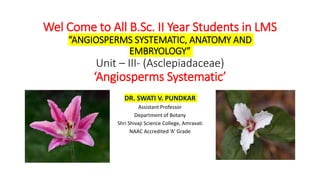
Asclepiadaceae family
- 1. Wel Come to All B.Sc. II Year Students in LMS “ANGIOSPERMS SYSTEMATIC, ANATOMY AND EMBRYOLOGY” Unit – III- (Asclepiadaceae) ‘Angiosperms Systematic’ DR. SWATI V. PUNDKAR Assistant Professor Department of Botany Shri Shivaji Science College, Amravati NAAC Accredited ‘A’ Grade
- 3. Distribution of Asclepiadaceae: The family Asclepiadaceae is commonly known as ‘Milk weed family’. In includes 320 genera and 2,000 species of world wide distribution, but mostly confined to tropics and sub-tropics. In India 332 species belonging to 35 genera are found. Calotropis procera Calotropis gigantea
- 4. Asclepiadaceae: Characters of Asclepiadaceae: Plants herbs, shrubs, mostly twiners and rarely trees; leaves opposite, simple, entire margin rarely alternate; inflorescence cymose or racemose; flowers hermaphrodite, pentamerous; calyx of 5 sepals, imbricate; petals 5, gamopetalous, corona arising as outgrowth of petals or stamens; stamens 5, fused with stigmatic disc forming gynostegium; pollens forming pollinia; carpels bicarpellary, syncarpous, ovaries and style free, only stigma fused to form disc, marginal placentation, fruit follicles.
- 5. Classification Bentham and Hooker Engler and Prantl Division- Phanerogams Division- Phanerogams Sub-division- Angiospermes Sub-division- Angiospermae Class- Dicotyledones Class- Dicotyledonae Sub-class- Gamopetalae Sub-class- Sympetalae Series- Bicarpellatae Order- Contortae Order- Gentianales Family- Asclepiadaceae Family- Asclepiadaceae
- 6. Common plants of the family: 1. Asclepias (Milk weed) – A red flowered plant. 2. Calotropis procera (H. Aak) – A xerophytic wild shrub. 3. Cryptostegia grandiflora – A large, stout climber. 4. Periploca calophylla – Shrub with coriaceous lanceolate leaves. 5. Gymnema tingens – Twining herb. 6. Marsdenia tenacissima (Rajmahal hemp) – A climbing shrub with very short stem. 7. Hoya longifolia (Wax plant) – A twining epiphyte with waxy leaves and flower. 8. Sarcostemma brevistigma – A wild plant. 9. Sarcolobus globosus – A climber which occurs in Sunderbans. 10-. Hemidesmus indicus- Anabtmui 11. Leptadenia reticulata- Dudhkadi 12. Perguleria daemia – Utranwel 13. Cryptolepis buchnani – Indian rubber twiner 14. Tylophora indica- Anantmul 15. Telosma pollida – Warshadodi
- 7. A. Vegetative characters: Habit: Perennial herbs (Asclepias) or shrubs (Calotropis, Leptadenia), climbers (Cryptostegia, Daemia), succulent (Stapelia) with latex. Root: A deep branched tap root.
- 8. Stem: Herbaceous, week and climbing or succulent, woody below (Calotropis), erect, twiner or climbers (Cryptostegia) cylindrical, rarely hairy and solid, latex present.
- 9. Leaves: Simple, petiolate, exstipulate, entire, opposite rarely whorled, waxy; in Dischidia rafflesiana leaves are modified into pitchers, reduced or absent (Periploca), succulent or throns or scales.
- 10. B. Floral characters: Inflorescence: (1) Cymose and (2) Racemose. Mostly umbellate cymes (Calotropis) or dichasial cyme ending in monochasial cyme.
- 11. Flower: Bracteate or ebracteate, pedicellate, complete, hermaphrodite, actinomorphic, rarely zygomorphic (Ceropegia), pentamerous, hypogynous.
- 13. Calyx: Sepals 5, polysepalous or gamosepalous-fused near the base, quincuncial aestivation, sometimes valvate.
- 14. Corolla: Petals 5, gamopetalous, 5 lobed, twisted aestivation or valvate, corona may be scaly or hairy out growth from petals – corolline corona in Cryptostegia, Cryptolepis or form staminal tube i.e. staminal corona in Calotropis and Asciepias.
- 16. In the typical members of the family the translator consists of two parts: (1) Corpusculum and (2) A pair of arms. The corpusculum is attached to the margin of stigma head between the anthers and the pair of arms is attached to the pollinia of the adjacent anther halves. In the members of the sub family Periplocoideae the translator consists of a spoon or funnel- shaped structure in between each anther, terminating below in a sticky disc. The granular pollen grains form one half of each of the two adjacent anthers, on maturity, pour into the concave receptacle of the translator. Certain appendages or horn-like projections are given out from the backs of the anthers, are known as cuculi, which secrete and store honey. These appendages form a corona known as staminal corona.
- 17. Gynoecium:- Bicarpellary, syncarpous, ovaries free, superior, enclosed in staminal tube, ovules many on marginal placentation, each carpel is unilocular; style 2, free, distinct; stigmas united to form a pentangular disc with which anthers are fused to form gynostegium.
- 18. Fruit: An etaerio of two, often widely divergent follicles.,Generally it is a pair of follicles. Sometimes there is only one follicle, because of the suppression of the other. Seed:Many small, compressed with long silky hairs. Usually the seeds are flat, ovate- oblong and are crowned by a fruit of hairs. These hairs facilitate the dispersal of the seeds by wind. The embryo is large.
- 19. Pollination: Entomophilous, translator mechanism. The pollination takes place strictly by means of the agency of insects. As an insect visits the flower, the sticky basal disc of translator turns outwards and adheres to the head of the insect visitor. The whole translator with its pollinia or pollen contents is carried over by the insect from one flower to another flower where the pollen grains are deposited on the stigmatic surfaces on the underside of the stigma-head.
- 20. Floral formula and Diagram Br
- 22. Economic Importance of Asclepiadaceae: 1. Food: Gymnema lactiferumyields latex which is used as food in Ceylon. 2. Fibres: Some plants like Daemia extensa, Calotropis procera, C. gigantea, Marsdenia and Leptadenia etc. yield silky fibres which axe used for making ropes, mat, stuffing pillows etc. 3. Medicinal: The source of medicine in the family is latex from which alkaloids are extracted. The roots of Oxystelma esculentum are specific for jaundice. Hemidesmus indicus is used in leucorrhoea, rheumatism and in snake bites. Daemia extensa is used in cough; asthma and diarrhoea.
- 23. 4. Rubber: Cryptostegia grandiflora is a natural source of rubber in India. 5. Poison: Some species of Asclepias are important as live-stock poison. The sap of Matelea has been used as an arrow poison. 6. Ornamental: Asclepias, Cryptostegia, Hoya, Huernia, Ceropegia, Periploca etc. are cultivated for ornamental purposes.